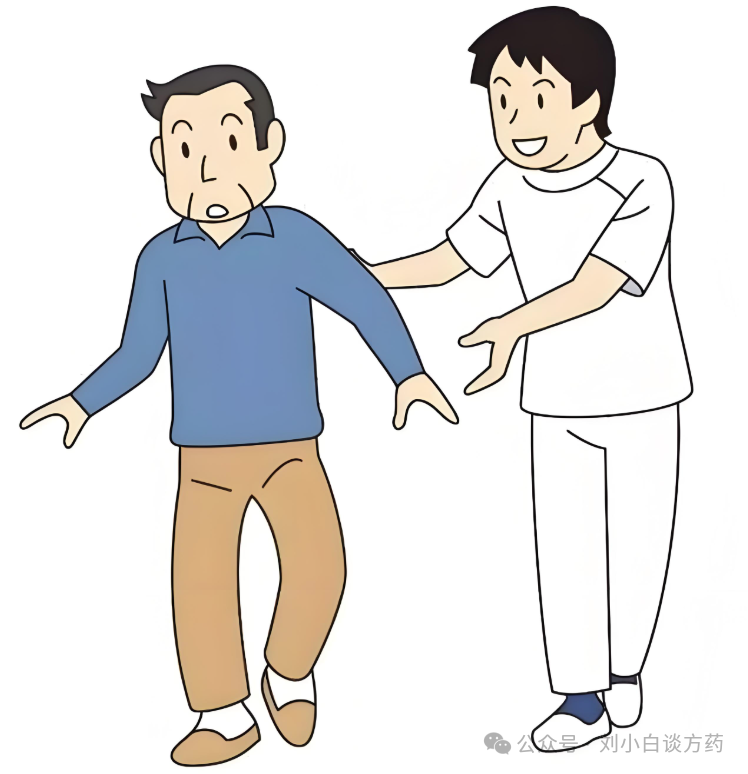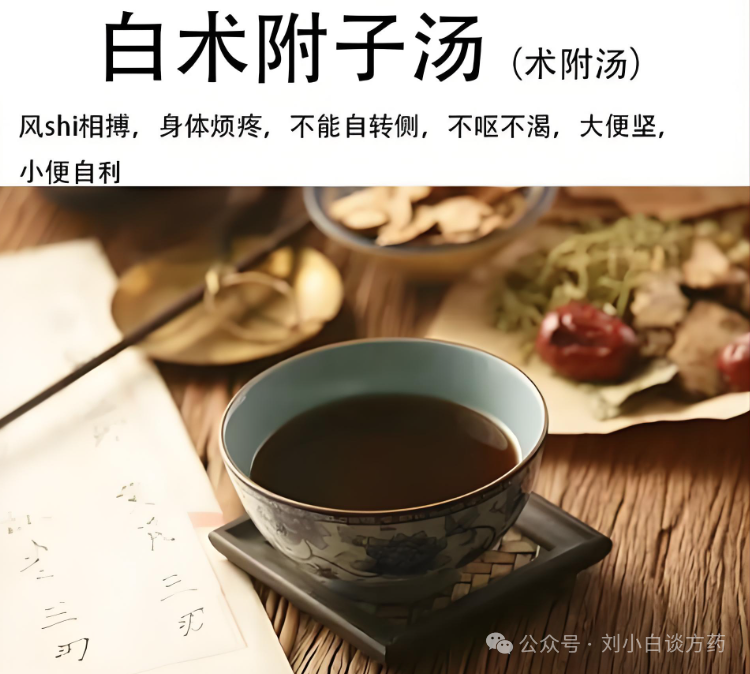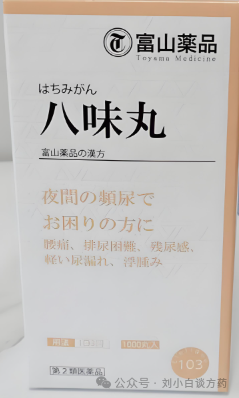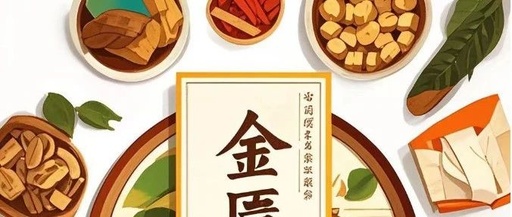Original Text:
Attached Formulas
”Gu Jin Lu Yan” Xu Ming Tang treats stroke with inability to self-recover, inability to speak, not knowing the painful area, or rigidity, unable to turn over. (Yao Yun treats the same as Xu Ming for postpartum blood loss in women and for the elderly and children)
Ma Huang (Ephedra) 3 liang, Gui Zhi (Cinnamon Twig) 3 liang, Dang Gui (Angelica Sinensis) 3 liang, Ren Shen (Ginseng) 3 liang, Shi Gao (Gypsum) 3 liang, Gan Cao (Licorice) 3 liang, Gan Jiang (Dried Ginger) 3 liang, Qiong Qiong 1 liang, Xing Ren (Apricot Kernel) 40 pieces
The above nine ingredients are boiled in 10 liters of water to obtain 4 sheng (approximately 1 liter), taken warm at 1 sheng, inducing slight sweating, lightly covering the back, sitting on a chair, if sweating occurs, recovery is expected; if not, continue taking, avoiding wind. It also treats inability to lie down, cough with reversed qi, and facial swelling.

”Qian Jin” San Huang Tang treats stroke with rigidity in hands and feet, pain in joints, irritability, heat in the heart, and aversion to cold, with no desire to eat or drink for days.
Ma Huang 5 fen, Du Huo (Angelica Pubescens) 4 fen, Xi Xin (Asarum) 2 fen, Huang Qi (Astragalus) 3 fen, Huang Qin (Scutellaria) 3 fen
The above five ingredients are boiled in 6 sheng of water to obtain 2 sheng, divided into three warm doses. The first dose induces slight sweating, the second induces heavy sweating. If there is heat in the heart, add 2 fen of Da Huang (Rhubarb); if there is abdominal fullness, add 1 piece of Zhi Shi (Bitter Orange); if there is reversed qi, add 3 fen of Ren Shen; if there is palpitations, add 3 fen of Mu Li (Oyster Shell); if there is thirst, add 3 fen of Gua Lou Gen (Trichosanthes Root); if there is prior cold, add 1 piece of Fu Zi (Aconite).
”Jin Xian Fang” Shu Fu Tang treats wind deficiency with heavy head and dizziness, extreme bitterness, inability to taste food, warming the muscles, tonifying the middle, and benefiting qi.
Bai Zhu (White Atractylodes) 2 liang, Fu Zi (Aconite) 1.5 pieces (processed to remove skin), Gan Cao (Licorice) 1 liang (roasted)
The above three ingredients are prepared with 7 qian (approximately 23 grams) of each, 5 slices of ginger, 1 date, and half a cup of water, decocted to 7 parts, strained, and taken warm.

Cui’s Ba Wei Wan treats foot qi rising into the abdomen, causing numbness in the lower abdomen.
Gan Di Huang (Rehmannia) 8 liang, Shan Zhu Yu (Cornus) 4 liang, Shu Yu (Dioscorea) 4 liang, Ze Xie (Alisma) 3 liang, Fu Ling (Poria) 3 liang, Mu Dan Pi (Moutan) 3 liang, Gui Zhi (Cinnamon Twig) 1 liang, Fu Zi (Aconite) 1 liang
The above eight ingredients are ground into powder, mixed with honey to form pills the size of a walnut, taken with wine, 15 pills twice daily.
”Qian Jin Fang” Yue Bi Jia Shu Tang treats extreme heat in the flesh, leading to loss of body fluids, opening pores, and excessive sweating, with wind in the lower body and weakness in the legs.
Ma Huang 6 liang, Shi Gao (Gypsum) 0.5 jin, Sheng Jiang (Fresh Ginger) 3 liang, Gan Cao 2 liang, Bai Zhu 4 liang, Da Zao (Jujube) 15 pieces
The above six ingredients are boiled in 6 sheng of water, first boiling Ma Huang, removing the foam, then adding the other ingredients, boiling to obtain 3 sheng, divided into three warm doses. If there is aversion to wind, add 1 piece of Fu Zi (Aconite) processed.
Analysis:
Xu Ming Tang is suitable for stroke caused by external pathogens leading to paralysis. The cause of this condition is the internal deficiency of qi and blood, combined with the disturbance of pathogenic qi. Wind invades the organs, causing the heart and spirit to be unresponsive, hence the inability to speak and not knowing the painful area. The external wind pathogen obstructs the meridians, leading to the body’s inability to self-recover and rigidity preventing movement. Treatment should focus on tonifying qi and nourishing blood while also dispelling wind and eliminating pathogens. This formula includes Ren Shen and Gan Cao to tonify qi; Chuan Xiong and Dang Gui to nourish blood and regulate the circulation; Ma Huang and Gui Zhi to disperse wind and eliminate pathogens; Shi Gao and Xing Ren to clear heat and open the lungs, combined with Ma Huang and Gui Zhi to disperse pathogens; Gan Jiang to warm the stomach. This will invigorate qi and blood, harmonize the defensive and nutritive qi, allowing the wind pathogen to exit, leading to recovery. This is used for stroke with both qi and blood deficiency combined with wind-cold; it is not suitable for those with yin deficiency and yang excess.
San Huang Tang treats dizziness due to yang deficiency combined with wind-cold. Stomach yang deficiency leads to dampness not transforming; clear yang does not rise, unable to warm the head, and turbid yin rises, combined with external wind pathogens, causing obstruction of the clear orifices, leading to heavy head and dizziness, with unbearable pain; dampness obstructing the stomach leads to inability to eat. Treatment should focus on warming and tonifying the yang of the spleen and kidneys, transforming dampness, and harmonizing the defensive and nutritive qi. The Shu Fu Tang is used for treating heavy head and dizziness due to yang deficiency combined with turbid yin rising, hence the term extreme bitterness. In clinical practice, in addition to the above symptoms, attention should also be paid to the pulse and tongue; the pulse should be either deep and weak or floating and empty, and the tongue should be pale with a white and slippery coating. The formula includes Fu Zi to warm kidney yang; Bai Zhu and Gan Cao to tonify the spleen and stomach, drying dampness; Sheng Jiang and Da Zao to benefit the spleen and stomach while harmonizing the defensive and nutritive qi. When yang qi is invigorated, dampness has a pathway to exit, allowing clear yang to rise and turbid yin to no longer ascend, combined with Sheng Jiang and Da Zao to harmonize the defensive and nutritive qi, ensuring no external pathogens remain. Thus, the heavy head and dizziness will be resolved.
Shu Fu Tang treats dizziness due to yang deficiency combined with wind-cold. Spleen and stomach yang deficiency leads to dampness not transforming; clear yang does not rise, unable to warm the head, and turbid yin rises, combined with external wind pathogens, causing obstruction of the clear orifices, leading to heavy head and dizziness, with unbearable pain; dampness obstructing the stomach leads to inability to eat. Treatment should focus on warming and tonifying the yang of the spleen and kidneys, transforming dampness, and harmonizing the defensive and nutritive qi. The Shu Fu Tang is used for treating heavy head and dizziness due to yang deficiency combined with turbid yin rising, hence the term extreme bitterness. In clinical practice, in addition to the above symptoms, attention should also be paid to the pulse and tongue; the pulse should be either deep and weak or floating and empty, and the tongue should be pale with a white and slippery coating. The formula includes Fu Zi to warm kidney yang; Bai Zhu and Gan Cao to tonify the spleen and stomach, drying dampness; Sheng Jiang and Da Zao to benefit the spleen and stomach while harmonizing the defensive and nutritive qi. When yang qi is invigorated, dampness has a pathway to exit, allowing clear yang to rise and turbid yin to no longer ascend, combined with Sheng Jiang and Da Zao to harmonize the defensive and nutritive qi, ensuring no external pathogens remain. Thus, the heavy head and dizziness will be resolved.
Cui’s Ba Wei Wan treats foot qi rising into the abdomen due to kidney yang deficiency. The kidney meridian originates in the foot and ascends to the abdomen. Kidney yang deficiency leads to poor qi transformation, resulting in water and dampness stagnation; dampness descends, causing swelling in the legs and feet, leading to foot qi. The lower abdomen is where the kidney meridian passes, and water and dampness accumulate, causing numbness and rigidity in the lower abdomen. Treatment should focus on warming kidney yang, transforming qi, and promoting urination; when water and dampness are expelled through urination, the numbness and rigidity in the lower abdomen will resolve. This formula is derived from the Jin Gui Shen Qi Wan, which can warm kidney yang and also nourish kidney yin, following the principle of seeking yang within yin, allowing yin to generate yang, thus restoring kidney qi. This treatment for foot qi is just one application; it can also treat kidney deficiency, consumptive disease, diabetes, phlegm-dampness, and women’s pregnancy-related conditions, thus requiring further study.

Yue Bi Jia Shu Tang is used to treat diseases caused by external invasion of wind-dampness, transforming heat and injuring fluids. External wind-dampness gradually transforms into heat; when wind prevails, heat prevails, injuring body fluids, leading to muscle atrophy over time. This results in emaciation, loss of fluids, open pores, excessive sweating, and weakness in the legs. Treatment should focus on dispelling wind, clearing heat, and eliminating dampness, using Yue Bi Jia Shu Tang. This formula includes Ma Huang to dispel wind and promote dampness; Shi Gao to clear internal heat; Sheng Jiang and Da Zao to harmonize the defensive and nutritive qi; Bai Zhu to strengthen and dispel dampness from the muscles. The combination of these herbs allows for the expulsion of wind, clearing of heat, elimination of dampness, and smooth circulation of the defensive and nutritive qi, leading to gradual alleviation of symptoms.
Conclusion:
Joint pain is characterized by swelling and pain in multiple joints, which can lead to deformity, with emaciation as the main symptom. Its formation is due to internal deficiency of liver and kidney, insufficient qi and blood, or weak yang qi as internal causes, combined with external factors such as sweating, bathing in water, drinking alcohol, and exposure to wind, leading to obstruction of the joints by wind, cold, and dampness, causing qi circulation to be hindered, resulting in this condition. In clinical practice, there are differences between wind-dampness predominance and cold-dampness predominance. In cases of wind-dampness predominance, symptoms include pain in the limbs and joints, emaciation, swelling of the feet, dizziness, shortness of breath, and a desire to vomit, treated with Zhi Mu Tang; in cases of cold-dampness predominance, the main symptom is joint pain with inability to flex or extend, treated with Wu Tou Tang.

